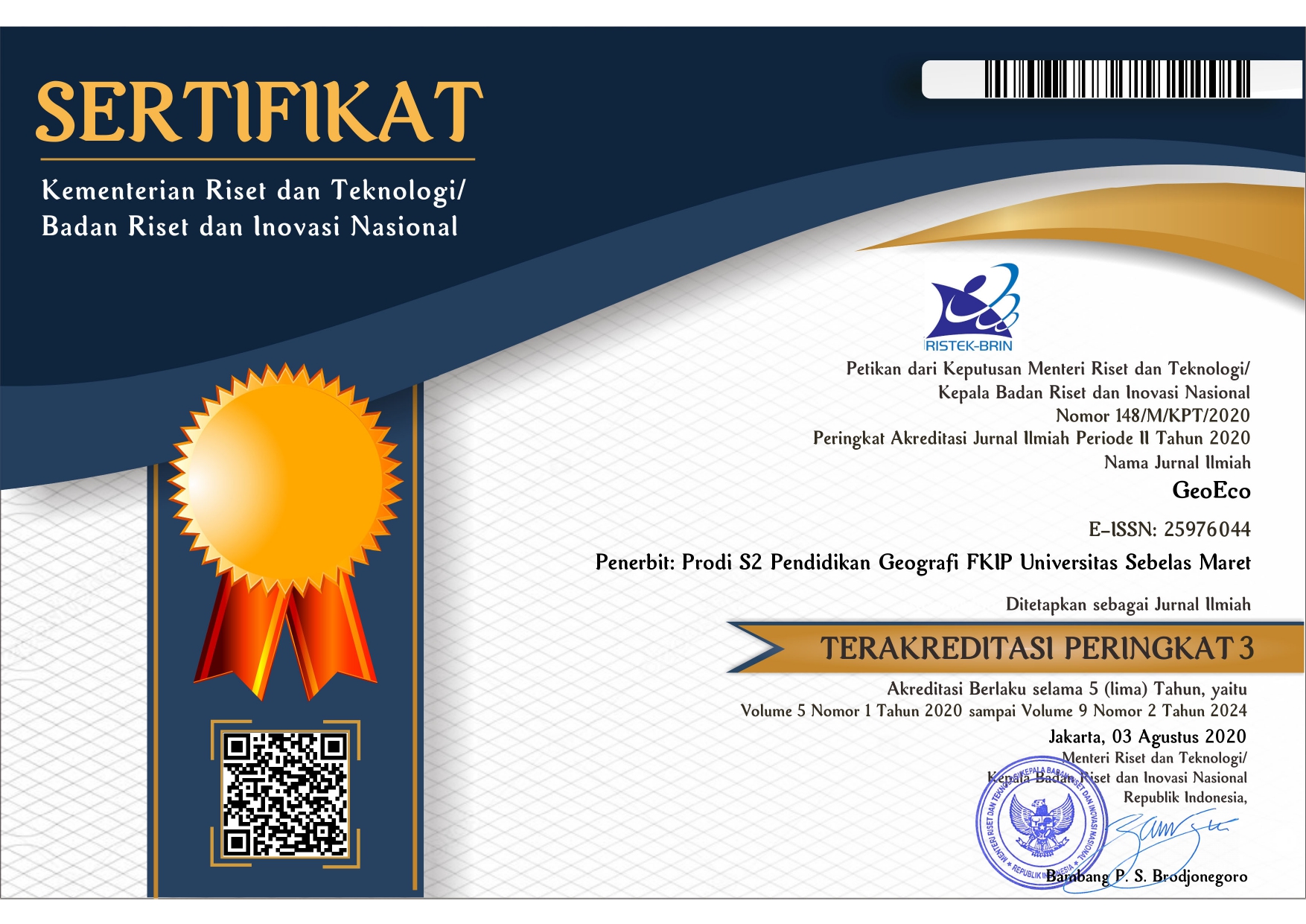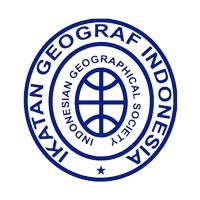ANALYSIS OF KARST ROCK DESERTIFICATION IN THE TROPICAL KARST REGION OF GUNUNG SEWU, TEPUS, GUNUNGKIDUL
Abstract
Keywords
Full Text:
PDFReferences
Al Khoury, I., Boithias, L., Bailey, R. T., Ollivier, C., Sivelle, V., & Labat, D. (2023). Impact of land-use change on karst spring response by integration of surface processes in karst hydrology: The ISPEEKH model. Journal of Hydrology, 626, 130300. https://doi.org/10.1016/j.jhydrol.2023.130300
Anggoro, D., & Budiyanto, E. (2018). PEMANFAATAN CITRA LANDSAT 8 OLI UNTUK ANALISIS DESERTIFIKASI BATUAN KARST GUNUNG SEWU BAGIAN TIMUR DI KECAMATAN PONJONG, GUNUNG KIDUL.
Ao, L., Wu, Y., Xu, Q., Zhou, Y., Chen, X., Liang, P., … Chen, H. (2025). The Role of Bedrock Topography in the Runoff Process and Soil Erosion on Karst Steep Slopes. Land Degradation & Development, 36(2), 533–544. https://doi.org/10.1002/ldr.5377
Budiyanto, E. (2014). Prosiding Pertemuan Imiah Tahunan (PIT) Ikatan Geograf Indonesia-2014.
Cahyanti, P. A. B., & Agus, C. (2017). Development of Landscape Architecture through Geo-eco-tourism in Tropical Karst Area to Avoid Extractive Cement Industry for Dignified and Sustainable Environment and Life. IOP Conference Series: Earth and Environmental Science, 83, 012028. https://doi.org/10.1088/1755-1315/83/1/012028
Cai, J., Yu, W., Fang, Q., Zi, R., Fang, F., & Zhao, L. (2023). Extraction of Rocky Desertification Information in the Karst Area Based on the Red-NIR-SWIR Spectral Feature Space. Remote Sensing, 15(12), 3056. https://doi.org/10.3390/rs15123056
Cao, D., & Wen, S. (2024a). Dynamic Change and Attribution Regarding Fractional Vegetation Coverage in Mengdong River Basin. Forests, 15(5), 746. https://doi.org/10.3390/f15050746
Cao, D., & Wen, S. (2024b). Dynamic Change and Attribution Regarding Fractional Vegetation Coverage in Mengdong River Basin. Forests, 15(5), 746. https://doi.org/10.3390/f15050746
D’Ettorre, U. S., Liso, I. S., Pisano, L., Zumpano, V., & Parise, M. (2023, May 15). Degradation and loss of soil in karst terrains. https://doi.org/10.5194/egusphere-egu23-5640
Do Nascimento, E. R., Sessegolo, G. C., Berra, E. F., Da Silveira, C. T., & Sampaio, T. V. M. (2024). A MINERAÇÃO EM ROCHAS CARBONÁTICAS NA REGIÃO METROPOLITANA DE CURITIBA- PR: DESAFIOS PARA A PRESERVAÇÃO DO PATRIMÔNIO CÁRSTICO E ESPELEOLÓGICO. RAEGA - O Espaço Geográfico Em Análise, 59, 43. https://doi.org/10.5380/raega.v59i0.93178
Goldscheider, N., Chen, Z., Auler, A. S., Bakalowicz, M., Broda, S., Drew, D., … Veni, G. (2020). Global distribution of carbonate rocks and karst water resources. Hydrogeology Journal, 28(5), 1661–1677. https://doi.org/10.1007/s10040-020-02139-5
Haryono, E., Adji, T. N., Cahyadi, A., Widyastuti, M., Listyaningsih, U., & Sulistyowati, E. (2022). Groundwater and livelihood in Gunungsewu karst area, Indonesia. In Groundwater for Sustainable Livelihoods and Equitable Growth (pp. 1–23). London: CRC Press. https://doi.org/10.1201/9781003024101-1
Hou, W., & Gao, J. (2020). Spatially Variable Relationships between Karst Landscape Pattern and Vegetation Activities. Remote Sensing, 12(7), 1134. https://doi.org/10.3390/rs12071134
Kang, Y., Shen, L., Li, C., Huang, Y., & Chen, L. (2024). Effects of vegetation degradation on soil microbial communities and ecosystem multifunctionality in a karst region, southwest China. Journal of Environmental Management, 363, 121395. https://doi.org/10.1016/j.jenvman.2024.121395
Liu, J., Zhou, G. Q., Jia, B., Yue, T., & Peng, X. Y. (2020a). KARST ROCKY DESERTIFICATION ANALYSIS BASED ON HISTORICAL DISP DATA TAKE TWO REGIONS FOR EXAMPLE. The International Archives of the Photogrammetry, Remote Sensing and Spatial Information Sciences, XLII-3/W10, 871–874. https://doi.org/10.5194/isprs-archives-XLII-3-W10-871-2020
Liu, J., Zhou, G. Q., Jia, B., Yue, T., & Peng, X. Y. (2020b). KARST ROCKY DESERTIFICATION ANALYSIS BASED ON HISTORICAL DISP DATA TAKE TWO REGIONS FOR EXAMPLE. The International Archives of the Photogrammetry, Remote Sensing and Spatial Information Sciences, XLII-3/W10, 871–874. https://doi.org/10.5194/isprs-archives-XLII-3-W10-871-2020
Lu, Xian-jian, Guo, Z., Yan, H., & Zhang, H. (2023). Rocky Desertification Feature Extraction and Spatio-temporal Evolution Analysis based on Decision Tree. 2023 8th International Conference on Communication, Image and Signal Processing (CCISP), 58–64. IEEE. https://doi.org/10.1109/CCISP59915.2023.10355793
Lu, Xiaxia, Sheng, M., & Luo, M. (2024a). Knowledge Mapping Analysis of Karst Rocky Desertification Vegetation Restoration in Southwest China: A Study Based on Web of Science Literature. Agronomy, 14(10), 2235. https://doi.org/10.3390/agronomy14102235
Lu, Xiaxia, Sheng, M., & Luo, M. (2024b). Knowledge Mapping Analysis of Karst Rocky Desertification Vegetation Restoration in Southwest China: A Study Based on Web of Science Literature. Agronomy, 14(10), 2235. https://doi.org/10.3390/agronomy14102235
Mandal, D., & Roy, T. (2024). Climate Change Impact on Soil Erosion and Land Degradation. https://doi.org/10.1007/978-981-99-7935-6_5
Niu, L., Zhang, Z., Liang, Y., & Huang, Y. (2022). Assessing the Impact of Urbanization and Eco-Environmental Quality on Regional Carbon Storage: A Multiscale Spatio-Temporal Analysis Framework. Remote Sensing, 14(16), 4007. https://doi.org/10.3390/rs14164007
Palacios-Cabrera, T., Valdes-Abellan, J., Jodar-Abellan, A., & Rodrigo-Comino, J. (2022). Land-use changes and precipitation cycles to understand hydrodynamic responses in semiarid Mediterranean karstic watersheds. Science of The Total Environment, 819, 153182. https://doi.org/10.1016/j.scitotenv.2022.153182
Putra, R. D., Adji, T. N., & Haryono, E. (2025). Karst rocky desertification delineation and estimation of potential soil loss in tropical karst cockpits. Kuwait Journal of Science, 52(3). https://doi.org/10.1016/j.kjs.2025.100422
Qian, C., Qiang, H., Qin, C., Wang, Z., & Li, M. (2022a). Spatiotemporal Evolution Analysis and Future Scenario Prediction of Rocky Desertification in a Subtropical Karst Region. Remote Sensing, 14(2), 292. https://doi.org/10.3390/rs14020292
Qian, C., Qiang, H., Qin, C., Wang, Z., & Li, M. (2022b). Spatiotemporal Evolution Analysis and Future Scenario Prediction of Rocky Desertification in a Subtropical Karst Region. Remote Sensing, 14(2), 292. https://doi.org/10.3390/rs14020292
Qian, C., Qiang, H., Qin, C., Wang, Z., & Li, M. (2022c). Spatiotemporal Evolution Analysis and Future Scenario Prediction of Rocky Desertification in a Subtropical Karst Region. Remote Sensing, 14(2), 292. https://doi.org/10.3390/rs14020292
Reinhart, H., Putra, R. D., & Rafida, M. R. (2023). Karst ecosystem services and their roles in the management of Gunung Sewu UNESCO global geopark. Sustinere: Journal of Environment and Sustainability, 7(3), 220–233. https://doi.org/10.22515/sustinere.jes.v7i3.349
Stevanović, Z. (2018). Global distribution and use of water from karst aquifers. Geological Society, London, Special Publications, 466(1), 217–236. https://doi.org/10.1144/SP466.17
Sunkar, A. (2008). Deforestation And Rocky Desertification Processes In Gunung Sewu Karst Landscape (Vol. 13).
Taminskas, J., Paskauskas, R., Zvikas, A., & Satkunas, J. (2006). Karst and Ecosystems. In Geology and Ecosystems (pp. 61–76). Boston, MA: Springer US. https://doi.org/10.1007/0-387-29293-4_6
Xiong, Y. J., Qiu, G. Y., Mo, D. K., Lin, H., Sun, H., Wang, Q. X., … Yin, J. (2009). Rocky desertification and its causes in karst areas: a case study in Yongshun County, Hunan Province, China. Environmental Geology, 57(7), 1481–1488. https://doi.org/10.1007/s00254-008-1425-7
Yue, X., Lu, H., Pan, X., & Zeng, J. (2024, October 21). Spatiotemporal Variation of Vegetation Coverage and Its Driver in a Typical Karst Rocky Desertification Area in Southwest China. https://doi.org/10.20944/preprints202410.1575.v1
Zhang, S., Wang, Y., Wang, X., Wu, Y., Li, C., Zhang, C., & Yin, Y. (2022). Ecological Quality Evolution and Its Driving Factors in Yunnan Karst Rocky Desertification Areas. International Journal of Environmental Research and Public Health, 19(24). https://doi.org/10.3390/ijerph192416904
Zhou, Y., & Chen, Q. (2025). RETRACTED: Evolution of karst rocky desertification and its response to land use changes in different geomorphologic environments. Journal of Intelligent & Fuzzy Systems, 48(1_suppl), 573–589. https://doi.org/10.3233/JIFS-241536
Zucca, C., Fleiner, R., Bonaiuti, E., & Kang, U. (2022). Land degradation drivers of anthropogenic sand and dust storms. CATENA, 219, 106575. https://doi.org/10.1016/j.catena.2022.106575
Refbacks
- There are currently no refbacks.












.png)

